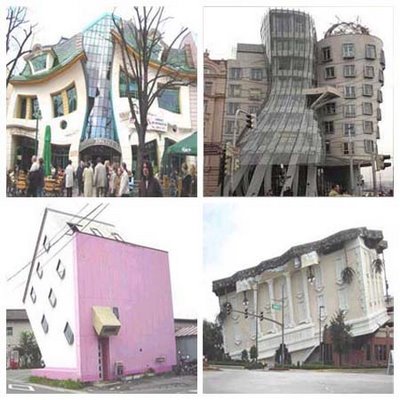Smart Buildings Make Smooth Moves

By Aussiegirl
From the article: Imagine a high-rise tower that braces itself against sudden strong winds by distributing stresses. Or a home that shakes the snow from its roof. It all seems a bit unsettling to me, living in a building that is like an animal, with lifelike behavior. Perhaps they will look like the buildings in the illustration!
Wired News: Smart Buildings Make Smooth Moves
Smart Buildings Make Smooth Moves
By Lakshmi Sandhana
What if buildings could function like living systems, altering their shapes in response to changing weather conditions or the way people use them?
That's the vision of a new breed of architects who are working on what they think is the future of architecture -- "responsive structures" that observe their internal and external environment and change form to suit any situation.
A building that mimics a living system would be able to sense and respond appropriately to exterior conditions like varying winds, temperature swings or changing sunlight. Inside, the building might change to accommodate crowd flow or better circulate warm air.
"If we could develop shelter ... that truly responds to the environment like a natural organism, that would be the most successful form of adaptive construction," says John Folan, an architect and assistant professor at the University of Arizona. "This is the wave of the future."
At the Office for Robotic Architectural Media & The Bureau for Responsive Architecture, Tristan d'Estree Sterk is working on shape-changing "building envelopes" using "actuated tensegrity" structures -- a system of rods and wires manipulated by pneumatic "muscles" that serve as the building's skeleton, forming the framework of all its walls.
By connecting the skeleton to embedded, intelligent systems, Sterk is creating smart structures that are light, extremely robust and capable of making extensive shape changes without consuming a lot of energy.
"Shape-changing envelopes offer architects the ability to produce buildings that condition themselves in very simple, natural and sustainable ways," says Sterk. "They enable buildings to be conceived of as systems that change shape to improve the way people live."
Sterk said there are other advantages. Imagine a high-rise tower that braces itself against sudden strong winds by distributing stresses. Or a home that shakes the snow from its roof.
Sterk said architects have long known that the way buildings are lit, heated and cooled is intimately related to a building's shape. Taller spaces heat and cool very differently from short spaces.
"Building skins clad in new generations of energy-making materials could alter their form to track the sun, enable greater shading or sunlight penetration while also producing energy," says Sterk. "A building like this could even eliminate the need for air conditioning by using shape to improve ventilation rates."
Sterk is working on a set of ultralightweight skyscrapers in Chicago.
"By using an exoskeletal, actuated tensegrity superstructure, the building lets wind blow through it, reducing harmful shaking and swaying," he says. "The frame also swivels and twists gently in the wind to control the building's center of gravity since it doesn't rely on its own weight to hold it in place; this allows architects to build taller and more sustainably."
While advances in technology have made interiors more intelligent and comfortable (intelligent lighting, smart air conditioning systems, etc.), the idea of a building as a whole changing shape is only just emerging because of the complexity of the task. Robert Skelton, director of the Structural Systems and Control Laboratory at the University of California at San Diego, is developing a new branch of mathematics to understand the structural equations that drive any natural construction.
Anders Nereim, chairman of the department of architecture, interior architecture and designed objects at the School of the Art Institute of Chicago, says it's important for a structure's exterior to change shape, since it directly affects the efficiency of the entire structure.
"Trees that bend are stronger and lighter than trees that don't bend," says Nereim. "The interior of a structure also needs to change responsively. We can't afford to have spaces that sit unusable for large portions of the day due to a fixed configuration."
Gian Carlo Magnoli, an architect and researcher at MIT's Kinetic Design Group, says buildings should be more like modern cars with complex safety and climate-control systems that respond to changing weather or road conditions.
"Sophisticated systems don't allow any misuse of brakes, wheels or fuel, and air bags instantly appear to protect us in case of extreme events," he says. "Our house rarely does all of this for us -- but we believe it could."


1 Comments:
Interesting, but there would remain the problem of keeping those "smooth moves" from breaking all the crockery and redistributing all the furniture.
Post a Comment
<< Home